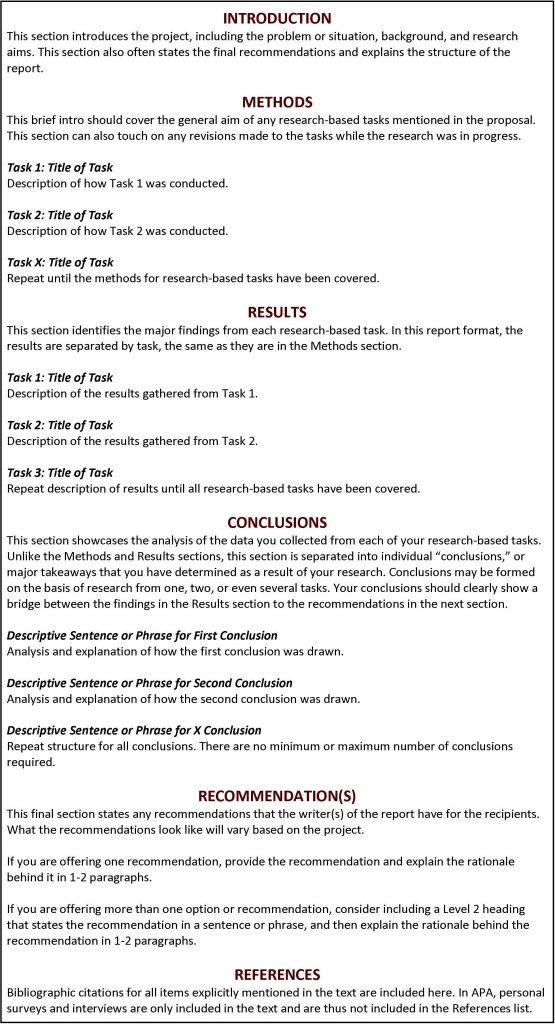20 – Recommendation Reports
Crafting Recommendation and Feasibility Reports: What to Remember
Matt McKinney
Recommendation and feasibility reports are among the most intricate and comprehensive documents you will craft as a technical writer. They often contain a variety of sections with different and specific purposes. Sections in recommendation and feasibility reports typically convey new information while also strategically repeating key information. Further still, these reports are written for multiple audiences, and therefore they must effectively guide each audience through the same content with differing levels of detail based on their needs. Finally, the writer usually needs to explore a variety of options and potential decisions based on data and research, and then they must account for their decision-making process in a reader-friendly manner. Figure 20.13[1] shows one possibility for structuring and designing the main body of a recommendation report.

When you are writing a recommendation or feasibility report, you can use what you have learned about analyzing rhetorical situations to focus your efforts specifically in framing content and structure. Some points you might reflect on include the following:
- The scope and purpose of your project.
Example
Conducting research and deriving potential solutions from your data (a recommendation report) vs. testing a number of predetermined solutions to see which one is most viable (a feasibility report).
- The audience(s) you are writing for, what they will find most interesting, and what section(s) they are most likely to read.
Example
A non-profit organization’s president may be most interested in your final recommendation, while a scientist who wants to replicate your research will likely be more interested in your data collection design.
- The genre and design conventions of recommendation reports in your field.
Example
If you are writing a recommendation report for a company you work for, you need to pay attention to how reports in the organization are typically formatted. This will help your coworkers and your boss understand how to read your document for their respective purposes.
- The part of the report you draft first.
Example
Waiting to write the Executive Summary until after you are satisfied with the sections that are more detail specific, such as Methods or Recommendations.
- The specific differences between each section’s purpose, so that sections repeating information are easier to distinguish from one another.
Example
Executive Summaries and Introductions both describe the issue or topic being investigated, but Introductions provide much more detail and contextual information on this, since it’s their only focus. By contrast, Executive Summaries also review other sections of the report, with a functional emphasis on results and recommendations.
- The level of detail you are using to showcase your thought process to the reader. (Hint: be generous.)
Example
A thorough Methods section helps the reader understand why the researcher’s forms of data collection are well-suited to addressing the issue, any logistics regarding data collection, and how forms of data will be triangulated.
- The incorporation of visuals into your document to facilitate reader comprehension of key findings and conclusions.
Example
Using a decision matrix to offer a criteria-based side-by-side comparison of multiple options vs. Using a decision tree to help the reader see the processes entailed in executing different options, as well as how those processes overlap and diverge.
Despite the challenges crafting a recommendation or feasibility report can present, the strategies for doing so apply to most complex documents: understand what is expected of you, break up the task as much as possible, and spend as much time or more prewriting and revising as you do drafting.
- Nicole Hagstrom-Schmidt and Kalani Pattison, “Template for ENGL 210 Recommendation Report,” 2021. This image is licensed under a Creative Commons Attribution-NonCommercial-ShareAlike 4.0 International License. ↵
